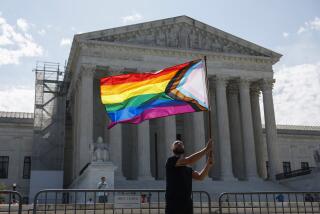The gay wedding march
- Share via
Even by the standards of this extraordinary year for gay rights — during which more than half of the 18 states that now recognize same-sex marriages were added to the list and the Supreme Court struck down part of the federal Defense of Marriage Act — the last couple of weeks have been remarkable. Within a few days, courts made gay marriage legal in New Mexico and Utah, and a ruling in Ohio forced some state recognition of such marriages.
FOR THE RECORD:
Marriage: A Dec. 30 editorial on same-sex marriage said the Supreme Court overturned the remaining state laws against interracial marriage in 1964. The court ruled in 1967. —
But those recent court decisions have also fed the long-standing perception among conservatives that gay marriage has been pushed through by “activist judges” forcing their personal beliefs on an unwilling populace. In fact, most of the states where marriage is recognized got to this stage through votes, mainly by state legislatures but in a few cases by the people themselves through ballot measures. Of the 18 states, only seven, including California, legalized gay marriage through court decisions.
It is, of course, preferable for progressive marriage laws to reflect the will of the people. In states that have voted for same-sex marriage, the laws are robust reflections of public acceptance. They are less susceptible to resentment and challenge.
YEAR IN REVIEW: 10 tips for a better life from The Times’ Op-Ed pages in 2013
But, in truth, the road to civil rights historically has involved a mix of approaches — popular opinion, lawmaking and court ruling — each affecting the others. The repeal of state laws against interracial marriage, for instance, followed this path, with a combination of judicial rulings and voluntary state repeals in the late 1940s and beyond until, in 1964, the U.S. Supreme Court overturned such laws in the 16 states that still had them. Some of the state decisions to repeal discriminatory marriage laws took place when a majority of Americans still favored such restrictions. But increased recognition of these rights by both legislatures and courts led to increased public support by the early 1960s.
It has been the same with gay marriage so far. The first state to recognize it — Massachusetts — was required to do so by a court ruling in November 2003, at a time when polls showed it would not have been approved by popular vote. Ten years later, a new poll found that Massachusetts voters had now changed their minds. Most of them believed the law had had no negative effects on the state, and 60% favored recognition of same-sex marriage.
As a growing number of states have sanctioned gay marriages, more Americans have had an opportunity to observe that they have no effect on traditional heterosexual marriage, which in turn leads to more acceptance and more laws passed. And societal recognition has an effect on judges, whose decisions have reflected that growing acceptance at the same time that they have been ahead of it.
Now, the fight for same-sex marriage is entering a new phase. The low-hanging fruit — states without strong laws banning gay marriage and with more progressive populations — is pretty much picked and the new battles will be in stiffly resistant territory. In 32 states, same-sex marriage is banned by a combination of laws and constitutional amendments, which means change is less likely to come via popular or legislative votes. Courts will play a bigger role.
The most recent case in point: Utah, viewed as a hot spot of antipathy toward same-sex marriage because it is home to the headquarters of the Mormon Church, which strongly opposes such marriages. The state so far has lost its efforts to halt a ruling by U.S. District Judge Robert J. Shelby that struck down Utah’s marriage ban. Utah officials are expected to vigorously defend the ban, probably all the way to the U.S. Supreme Court, which has not yet issued a broad ruling on same-sex marriage. Earlier this year, the high court struck down parts of the Defense of Marriage Act that affected federal recognition of state marriage laws, but that’s a far cry from recognizing a constitutional right to same-sex marriage. It is unclear how the court would rule.
One thing, though, is certain. Despite anger toward these supposedly anti-democratic decisions, judicial rulings have a necessary role to play in the advancement of civil rights, even when public and legislative opinion isn’t on the same side. Especially when it isn’t.
More to Read
Sign up for Essential California
The most important California stories and recommendations in your inbox every morning.
You may occasionally receive promotional content from the Los Angeles Times.










